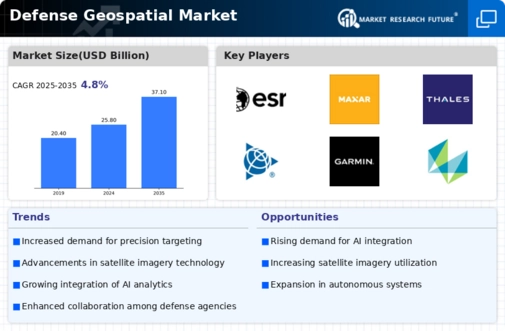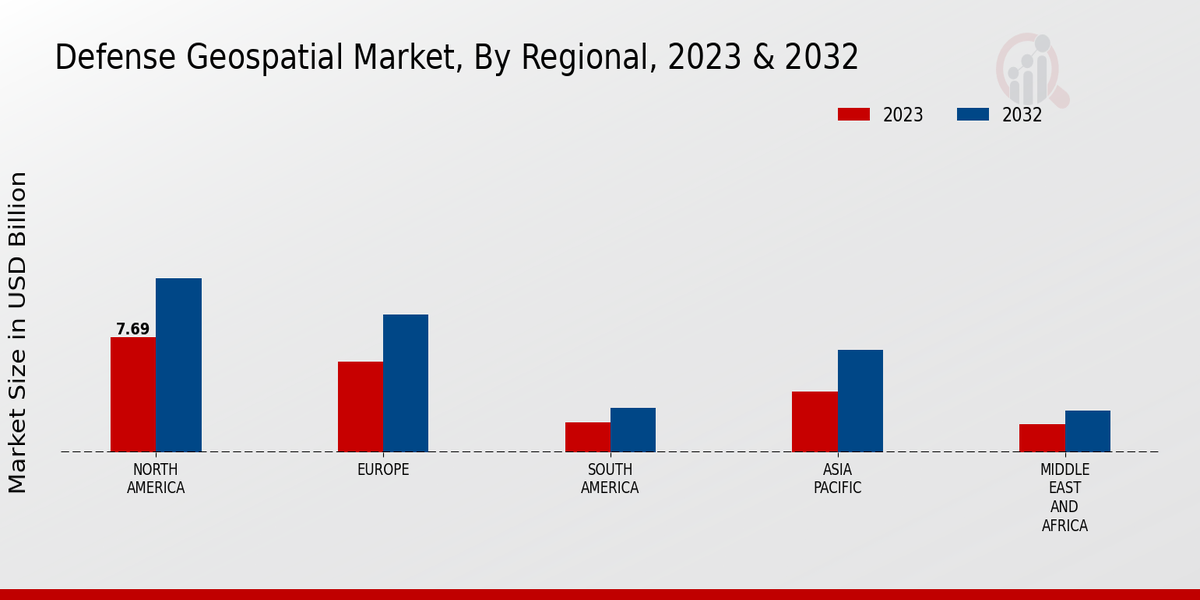Geopolitical Tensions
Geopolitical tensions across various regions are driving the demand for geospatial intelligence in the Global Defense Geospatial Market Industry. Nations are increasingly concerned about territorial disputes and security threats, prompting them to invest in advanced geospatial technologies for surveillance and reconnaissance. The ongoing conflicts in regions such as Eastern Europe and the South China Sea illustrate the urgency for accurate geospatial data to inform military strategies. This heightened focus on national security is likely to sustain market growth, as countries seek to enhance their situational awareness and operational readiness through improved geospatial capabilities.
Market Growth Projections
The Global Defense Geospatial Market Industry is poised for substantial growth, with projections indicating a market size of 25.8 USD Billion in 2024 and an anticipated increase to 37.1 USD Billion by 2035. This growth trajectory suggests a compound annual growth rate of 3.36% from 2025 to 2035, reflecting the increasing importance of geospatial technologies in defense operations. The market expansion is driven by various factors, including rising military expenditures, technological advancements, and the integration of geospatial data into defense strategies. These projections highlight the evolving landscape of the defense sector and the critical role of geospatial intelligence in shaping future military capabilities.
Technological Advancements
Rapid technological advancements are significantly influencing the Global Defense Geospatial Market Industry. Innovations in satellite imagery, drone technology, and artificial intelligence are transforming the landscape of defense operations. Enhanced data analytics capabilities enable military forces to process vast amounts of geospatial data efficiently. For example, the integration of AI in geospatial analysis allows for real-time decision-making, which is crucial in combat scenarios. As these technologies evolve, they are expected to contribute to the market's growth, with projections indicating a market size of 37.1 USD Billion by 2035. This evolution underscores the necessity for defense organizations to adopt cutting-edge geospatial solutions.
Increased Military Expenditure
The Global Defense Geospatial Market Industry is witnessing a surge in military expenditure across various nations. Governments are allocating substantial budgets to enhance their defense capabilities, which includes investments in geospatial technologies. For instance, the global military spending is projected to reach approximately 25.8 USD Billion in 2024, reflecting a growing recognition of the importance of advanced geospatial intelligence in modern warfare. This trend is likely to continue, as nations prioritize the acquisition of sophisticated mapping and surveillance tools to bolster their strategic operations. The emphasis on precision and situational awareness is driving demand for innovative geospatial solutions.
Integration of Geospatial Data in Defense Strategies
The integration of geospatial data into defense strategies is becoming a critical component of military planning in the Global Defense Geospatial Market Industry. Armed forces are recognizing the value of geospatial intelligence in enhancing operational efficiency and effectiveness. By leveraging geospatial data, military planners can optimize resource allocation, improve mission planning, and enhance situational awareness. This trend is expected to drive market growth, as defense organizations increasingly adopt geospatial solutions to support their strategic objectives. The emphasis on data-driven decision-making is likely to result in a compound annual growth rate of 3.36% from 2025 to 2035, highlighting the importance of geospatial technologies in modern defense operations.
Growing Demand for Cybersecurity in Geospatial Applications
As the reliance on geospatial technologies increases, so does the demand for robust cybersecurity measures within the Global Defense Geospatial Market Industry. The integration of geospatial data into military operations raises concerns about data integrity and security vulnerabilities. Consequently, defense organizations are prioritizing cybersecurity to protect sensitive geospatial information from potential cyber threats. This focus on cybersecurity is likely to drive investments in secure geospatial solutions, ensuring that military operations remain resilient against cyberattacks. The growing awareness of cybersecurity risks associated with geospatial applications underscores the need for comprehensive security protocols in defense strategies.


 Source Primary Research, Secondary Research, Market Research Future Database and Analyst Review
Source Primary Research, Secondary Research, Market Research Future Database and Analyst Review










